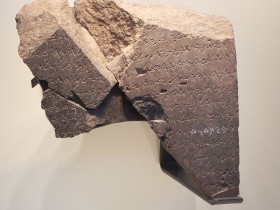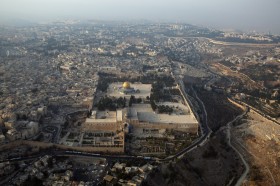The Generative Power of The Always-Yet-Never-Here Apocalypse
The funny thing about the apocalypse is that it has never happened, and yet it is always in our face and right around the corner. […]
King David Slept Here
For one thing, the archaeological search for David, and for the United Monarchy under him and his son Solomon, seems to assume that tangible proof – like the letter the dog dug up – exists, just waiting to be found. It appears to underlie claims of the discovery of buildings like David’s palaces in […]
The Return of David and Solomon?
Buried beneath the houses of Silwan, a small neighborhood south of the walls of the Old City of Jerusalem, lie the remains of four thousand years of human history. As elsewhere in the Middle East, in Silwan history is counted by ages […]
An Afternoon at the Museum - The Dead Sea Scrolls
By: Kaitlynn Anderson Saturday, September 21st, was a beautifully sunny, breezy day. I gathered my equipment and headed off to Westborough, MA. My plan? To see Dr. Eric Meyers lecture on the Dead Sea Scrolls and experience the exhibit at the Museum of Science. The lecture took place at the Good Shepherd Lutheran Church, and […]
Tel Hazor Bronze Age Photo Gallery
Photo Gallery: Here’s a gallery all the images that appear in Near Eastern Archaeology 76.2 for Hazor in the Middle and Late Bronze Ages. Smaller versions of some of the images also appear to illustrate the abridged version of the article on Hazor’s Ceremonial Precinct found on the ASOR Blog / ANE Today which you can […]
The Ceremonial Precinct in the Upper City of Hazor: What Does the Identification As a Temple or Palace Have to Do With Joshua’s Conquest?
ANE Today Editorial Introduction:* Hazor, “the head of all those kingdoms,” has a unique place in Biblical Archaeology. It is the largest tell in the Southern Levant, and a city-state whose importance resonated throughout the Middle and Late Bronze Ages. Hazor is also specifically named in the Book of Joshua as one of the enemies […]
The Big Dig Video Roundup
Sites and Finds Deep Time at Tall Hisban, Jordan In Focus: Abel Beth Maacah Bethsaida, Israel—Take a Tour of Current Excavations Illustrated lectures Everyday Life from the Archaeological Record: Prof. Aren Maeir Sarah Parcak: Archeology from space Ashkelon: Seaport of the Philistines, Lecture by Lawrence Stager You can find more videos on the Friends of […]
Near Eastern Archaeology in Malta
By: Anthony J. Frendo The Maltese archipelago lies practically at the centre of the Mediterranean, roughly midway between the eastern and the western Mediterranean Sea, and between the island of Sicily to its north and Libya to its south. Given this unusual location – between the Near East and Classical worlds and at the epicenter […]
Cooking in the Hebrew Bible
By: Cynthia Shafer-Elliott, Ph.D., William Jessup University It is an understatement to say that within US culture there is a keen interest in food. Turn on any TV and one will see entire channels dedicated to the cooking and eating of food, with chefs becoming minor celebrities. Our interest in food has spilled over into […]
The Renewed Hazor Excavations
By: Amnon Ben-Tor, The Hebrew University of Jerusalem Edited and abridged from NEA 76.2: 66–67 (see editorial note below) Tel Hazor, “the head of all those kingdoms” (Joshua 11:10), is the largest tell in Israel and encompasses a total of approximately 800 dunams (200 acres). With the exception of two gaps in the settlement, […]
The Virtual World Project: Touring The Ancient World
By: Ronald A. Simkins and Nicolae Roddy, Creighton University There is nothing quite like teaching at an archaeological site, where ancient remains almost speak out to students as witnesses of the past. Both authors have led study tours in Israel, taking students to archaeological sites like Tel Dan, Bethsaida, Megiddo, Arad, Beer-sheba, and others, lecturing […]
The Ancient Near East in Brazil and Argentina From the Origins of Research to the Present
By: Josué Berlesi Brazil and Argentina are not the first places you think of for ancient Near Eastern studies. But the story of ancient Near Eastern studies in these places is both interesting in its own right and says important things about education and culture in these countries. There are similarities between the discipline in […]
Biblical Archaeology in Germany – Does it Have a Future?
By: Martin Peilstöcker What if Biblical Archaeology went extinct in your native country? More than twenty years ago I left my native Germany to get a Ph.D. at Tel Aviv University and to work for the Antiquities Authority in Israel. But when I returned in, the situation I found in Germany came as a […]
Thomas Verenna: History’s ‘The Bible’ in Broader Contexts
By: Thomas Verenna This entry is reblogged from The Musings of Thomas Verenna. You can find the original entry here and his other posts on The Bible series here. In lieu of writing a much longer piece for an online journal, I have thought it useful to open up some to a conversation concerning the History Channel’s […]
Wil Gafney: History Channel’s Satan and President Obama
By: Wil Gafney, Associate Professor of Hebrew and Old Testament at The Lutheran Theological Seminary at Philadelphia. This entry is reblogged from Dr. Wil Gafney’s blog. You can find the original entry here and Dr. Gafney’s other posts on The Bible series here. Many viewers of the History Channel’s Bible mini-series saw and see a resemblance between the character […]
Mark Goodacre: The Bible Series — Drama and Historical Context
By: Mark Goodacre, Associate Professor of Religion at Duke University This entry is reblogged from NT Blog. You can find the original entry here and Dr. Goodacre’s other posts on The Bible series here. March 21 While I realize that the only thing people seem to want to talk about at the moment in connection […]
Fulfilling my Dream
By: Kristen Johnson, 2012 Heritage Fellow As someone who has spent a large portion of their adult life studying the intricacies of the Hebrew Bible narrative, subscribing to Biblical Archaeology Review, and learning ancient dead languages like Biblical Hebrew, getting the opportunity to experience my studies tangibly in their natural habitat of Israel through an archaeological […]
From Code to Discourse: The Semantics of Ancient Near Eastern Ritual
By: Yitzhaq Feder, University of Haifa, Educational and Cultural Affairs Fellow My fellowship at the Albright Institute provided me with the opportunity to make significant progress in my large-scale inquiry into the origins of ritual symbols and their sociological and political functions in cultural discourse. This project builds upon the recognition of the foundational role […]
A Response to Chris Rollston’s Reading of the Ossuary from Talpiot Tomb B
EnglishEnglishFrenchPowered by TranslateBy: H. Gregory Snyder, Professor of Religion, Davidson College Back in October, James Tabor invited me to join in a conversation that was underway between himself, Richard Bauckham, and Jim Charlesworth. Tabor submitted eleven photos of the ossuary bearing the four-line inscription for our inspection, and all of us engaged in a lengthy debate […]
THE FOUR-LINE GREEK INSCRIPTION FROM A TALPIYOT TOMB: EPIGRAPHIC NOTES AND HISTORICAL DISCUSSIONS
Christopher A. Rollston, Toyozo Nakarai Professor of Old Testament and Semitic Languages, Emmanuel Christian Seminary Introduction The publication of a four-line Greek inscription from a tomb in East Talpiyot (Jerusalem) has generated substantial interest, especially because of the dramatic claims surrounding it (Tabor and Jacobovici). James Tabor has argued that this inscription reads as […]






